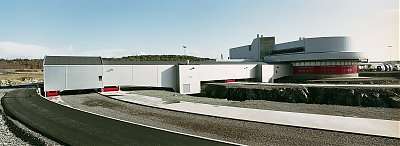|
| |||||
|
More Than 2,000 Crash Tests Performed At Volvo Cars Safety Centre
3rd July, 2007 | ||||
|
The Volvo Cars Safety Centre has reached a milestone in crash safety research. The Centre has performed more than 2,000 crash tests since its inauguration in the year 2000. The level of activity has grown over the years. Ten cars per week are now tested in the crash test laboratory - one of the leading facilities of its type in the world. The Volvo Cars Safety Centre is designed to reproduce crashes of many different kinds. The crash test laboratory is equipped with two tracks, one movable and one fixed. The movable track can sweep by up to 90 degrees to enable tests of all kinds, from frontal to side collisions, to be carried out between cars travelling at different angles and different speeds. The permanent track is long enough to enable the cars to be accelerated to speeds up to 120km/h. A series of other tests, such as rollover crashes or collisions with animals or other objects in the surrounding environment, can also be performed. More than 100 crash tests per model "To offer cars with a world-leading standard of safety, we have to verify that the systems protect occupants of various sizes at a wide range of speeds and in a variety of crash situations. It is the capacity to accurately replicate real-life crashes that makes our facility unique," explains Magnus Krokström, senior manager at the Volvo Cars Safety Centre. In total, about 450 crash tests are performed annually. Since the designation of the Volvo Cars Safety Centre as a Safety Centre of Excellence for the Ford Motor Company, other makes of cars produced by the group - including Jaguar, Land Rover and Ford - are also tested there. Reproduction of real-life crashes Because new legislation, market forces and safety systems constantly present the laboratory with new challenges, it is important to maintain close contact with the research community to ensure that resources are allocated correctly with an eye to future developments. For example, when initially designing the Safety Centre in 1996, it was foreseen that compatibility, in the context of crashes between large and small cars, would be an important area of research in the future. And so it has proved. Other types of testing that have grown in importance in recent years include rear-end collisions, which have become increasingly common in heavy urban traffic, and angled side collisions, which are a common occurrence at intersections. "Although we have had to make some modifications since the early days, there are now almost no limits to what we can do in the laboratory," says Krokström. Planning and follow-up "Although test data can be read out within an hour, manual inspection of car and dummies is also required. Our analysts deliver a preliminary report to the car project team within 24 hours. This is followed by a more detailed analysis that can take up to a fortnight;" says Krokström. Virtual simulations Testing of preventive safety systems - systems that assist a driver to avoid a crash - has also begun recently. Testing these advanced safety systems requires effective testing methods which are much more advanced than the first Volvo crash test half a century ago when a car was rolled down a hill to hit a concrete wall - this represents one of the biggest challenges facing the Volvo Cars Safety Centre at Torslanda in Göteborg, Sweden. | |||||
ABN 47106248033 |
 |
All rights reserved. |
